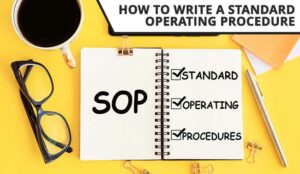A Standard Operating Procedure (SOP) is like having a set of instructions for your contact centre, but where do you start if no one in your team has attempted this before? (Or someone has done it so poorly you’ve been tasked with giving your current SOP a refresh?)
To help, our Editor Megan Jones interviewed both Jason Roberts, Founder at Appropriate Consulting, and Garry Gormley, Founder of FAB Solutions, about their experience of writing, using and maintaining Standard Operating Procedures, asking why they are fundamental to your operation and what you really need to know to get it right first time.
What Is a Standard Operating Procedure (SOP) and Why Do You Need One?
Quite simply, a Standard Operating Procedure gives a detailed response to the question “What do you do around here?”
As Garry Gormley explains:
“If you think of them as work instructions, it can make it a really clear and simple concept to get your head around.”
At a high level, a well-written Standard Operating Procedure should explain to you:
- What is the purpose of your team(s)?
- What are they there to do?
- Who are you there to serve?
- How do your processes operate and guide your agents to support all of the above?
As Jason Roberts adds:
“A Standard Operating Procedure for me is a guidebook. It’s like a Haynes Manual for your contact centre on how to do things well.
“That’s what your Standard Operating Procedure should feel like. It’s a guide for any new people joining your team to walk through the door and understand exactly what you do.”
Whilst it may seem like a very bland and tedious exercise to complete, it’s fundamental to understanding how your contact centre is structured, and there are many benefits to having a well-written SOP in place, including:
- Creating continuity and consistency for everyone involved – with a guide that clearly outlines how your agents and wider function operate and supports managers and team leaders in how to run the day-to-day operation. (For example, an SOP can help to ensure that frequent and repetitive tasks are completed consistently across the team.)
- Enabling better communication with the wider organization, by having this all written down to promote what your contact centre does as a function and how it supports the wider organization.
- Helping with audits and opportunities for continuous improvement, by highlighting (all in one place) what you are doing and why.
As Jason continues, “A Standard Operating Procedure is a fundamental starting point for driving change and innovation. After all, you can’t really change your contact centre and decide what you want to do tomorrow if you don’t have a clear understanding of what you’re doing today!”
5 Steps to Writing a Standard Operating Procedure (SOP)
1. Choose the Right Person to Write It (Who Will Actually Enjoy the Process)
There are lots of personality types out there, so it’s important to choose the right person for the job, as you will need someone detail-orientated to see the project through to the highest possible standard, as Jason explains:
“Choose someone who is meticulous and precise in their work. Someone who will love the process and can be relied upon to dot the i’s and cross the t’s at every step.”
2. Find a Voice to Represent Every Department

To create your Standard Operating Procedure, you need to include a voice from every department – and even external stakeholders too.
This will help to make sure that you gather a clear picture of what you do and how it supports and impacts other departments. Encourage your team to challenge you, to ensure the end product reflects reality.
As Garry adds, “Avoid creating your SOP in a silo! For example, frontline agents often have valuable insights into what works and what doesn’t, so be sure to include rather than exclude them.”
3. Index Every Last Detail
Quite simply, your Standard Operating Procedure should document everything from your IT architecture, your facilities and testing processes, right through to access to your recovery plans and what to do in the event of a fire – all listed in an easy-to-navigate index.
When drilling down specifically into customer management, you should also include:
- Who are your customers?
- Who are your partners?
- What are your processes?
Don’t forget to also include information about what systems are required, as well as the outcomes you’re looking for.
As Garry continues:
“SOPs that don’t reflect real-world practices can be impractical, leading to non-compliance or lack of adherence, and ultimately to agent frustrations as they don’t feel heard.”
4. Aim for Length (2 Pages Just Isn’t Long Enough!)

Creating a Standard Operating Procedure isn’t an exercise in brevity!
As Jason comments:
“I’ve known some SOPs to cover over 200 pages, particularly if they’re being printed as a ‘show and tell’ document for someone to take away with them.
“By contrast, some can be more succinct, but what you tend to find is that these shorter SOPs are in a web page format that links to additional resources – so the level of detail is still there. Use appropriate technology to enable easy maintenance for updating, as it can also serve as an artefact in an internal knowledge base.”
5. Make Sure Someone Owns It
You also need to make a clear decision about which department (or even individual) owns your Standard Operating Procedure document and will take longer-term responsibility for sharing it with the relevant parties and keeping it updated.
Typically, you should look to those in your governance and compliance functions whose day job is to keep a close eye on risk and strategy.
Mistakes to Avoid When Writing a Standard Operating Procedure
When creating or reviewing the Standard Operating Procedures for your contact centre, try to avoid the following mistakes:
Making It Too Confusing
Mapping out overly complex procedures in a way that’s confusing or difficult to follow can lead to the people using them making mistakes and getting frustrated – and ultimately even decreasing productivity.
Not Keeping It Updated
Don’t forget to put a model in place that outlines your change procedures, as there will need to be a clear exchange of information update that also goes through your SOP.
As Jason explains:
“In terms of continuous improvement and innovation, your SOP should never be a document that just sits on the shelf. That’s where, historically, many people have gone wrong.”
Being Too Rigid
Rigid SOPs can’t accommodate unexpected situations or individual customer needs and often don’t allow for exceptions to the process – leading to fear from agents of getting it wrong because the process says XYZ.
This can lead to poor customer service and poor outcomes and frustrated agents who feel they can’t use their judgement for fear of being penalized by QA or the ‘process police’!
Creating flexible and user-friendly SOPs that reflect real life can enhance the performance and satisfaction of both your agents and your customers. It is a great way to build on the culture of the brand, by encouraging colleagues to consider the context of the situation as a part of the outcome they plan to propose.
Stop Putting It Off!
Finally, if you’ve been tasked with writing or updating your SOP, stop putting it off… Bite the bullet and get it done!
As Garry concludes:
“The first mistake people need to avoid is not having your SOP outlined at all! How do we expect teams to follow processes consistently if we don’t clearly outline the process and procedures they should be following?”
For more on contact centre documentation and guidelines, read these articles next:
- Getting Started With Customer Service Mantras and Vision Statements
- Using Scheduling Playbooks to Manage Spikes in Service Demand
- What Should a Customer Value Proposition Look Like?
Author: Megan Jones
Reviewed by: Xander Freeman
Published On: 30th Jul 2024 - Last modified: 18th Sep 2025
Read more about - Call Centre Management, Customer Service, Editor's Picks, Garry Gormley, Jason Roberts, Leadership, Management Strategies, Top Story










































